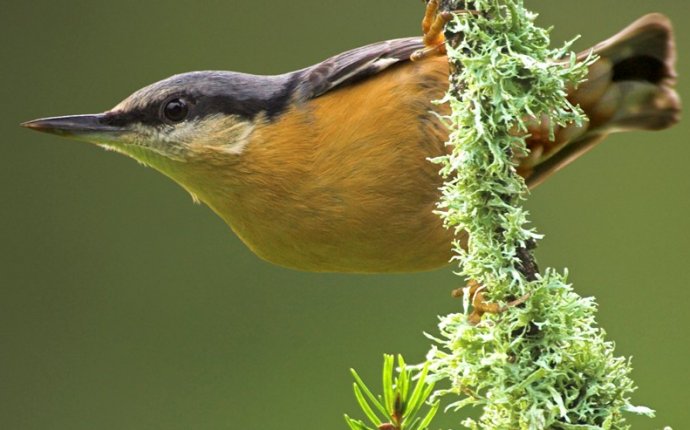
Little Bird with black head
The American Goldfinch is a small yellow-and-black bird, and one of the most vibrant you will see in your yard. The male has striking bright-yellow plumage with a black cap, where the female has a duller yellow-brown color and no cap. In the winter, both sexes molt into an olive-brown color.
The Goldfinch is a seed-eater who will readily come to your bird feeder. Sunflower seeds are a favorite, as is njyer or thistle seed. Even better, plant a few sunflowers and allow natural thistle to grow in your yard and watch the little Goldfinch harvest straight from the plants in the late summer and autumn.
American Robin
The American Robin will not come to a seed feeder, but you may attract it using a ground feeder stocked with mealworms or similar. However, there is really no need to go out of your way to bring this bird around. It will happily hunt worms, grubs and insects in your yard throughout the spring and summer.
In most areas of the Northeast the American Robin migrates south in early autumn and returns in early spring.
Baltimore Oriole
Here is another bird that will not come to your seed feeder. You may have some luck attracting it with it with citrus fruit or special Oriole nectar feeders. On my property I see this bird most often in the springtime, when the blossoms are out on my apple and pear trees. The Oriole will flit from branch to branch, merrily singing away as it examines the flowers.
Males have a bright orange breast with dark black head and wings. Females have a more yellowish breast and lighter colors on the head and wings.
Black-Capped Chickadee
One of smallest birds in your backyard is also one of the boldest. The Black-capped Chickadee is extremely tolerant of humans, and has even been known to take food from a person’s hand. Chances are you are already familiar with the song of this little bird, whether you know it or not. The familiar two-tone whistle and chick-a-dee-dee-dee are common sounds throughout the Northeast.
The Black-capped Chickadee is very easy to attract with a simple feeder and seed mix. You may wish to use a smaller tube feeder for species like the Chickadee, Goldfinch and other small birds, to prevent larger bully birds from pushing them around.
Blue Jay
Speaking of bullies, the Blue Jay is a bird that has somewhat of a reputation as the bad guy of the backyard. It’s easy to see why: Blue Jays are highly intelligent and larger than most other songbirds. They use these tools to their advantage, sometimes chasing away other birds or even attacking their nests.
But the Blue Jay’s smarts also serve to help other bird species. Blue Jays are often the first to sound an alarm when a predator is near, and their loud communication can alert other birds to a food source.
Chipping Sparrow
There are several sparrows in the Northeast, and sometimes they are a little tough to tell apart. The Chipping Sparrow is among the most common, and can be distinguished by its reddish-brown cap, relatively white breast and defined markings. This little bird has no trouble mingling with other smaller birds at your feeder, or foraging on the ground underneath, but you will also see it hunting insects in the branches of trees.
You will often hear the Chipping Sparrow chirping away or “chipping” from the tops of trees, and this is presumably where it gets its name.
Dark-eyed Junco
The Dark-eyed Junco makes an appearance in the Northeastern United States during the winter months, though I have occasionally witnessed a lone Junco sticking around well into the summer. More typically, this bird will be gone by late spring, having returned to its summer breeding grounds in Canada.
These guys are easy to spot as they will congregate on the ground beneath your feeder to forage for seed. Their dark-gray backs and light-colored bellies make them stand out, especially if there is snow on the ground. In fact, some people in my area call them snowbirds because they are so visible in winter.









